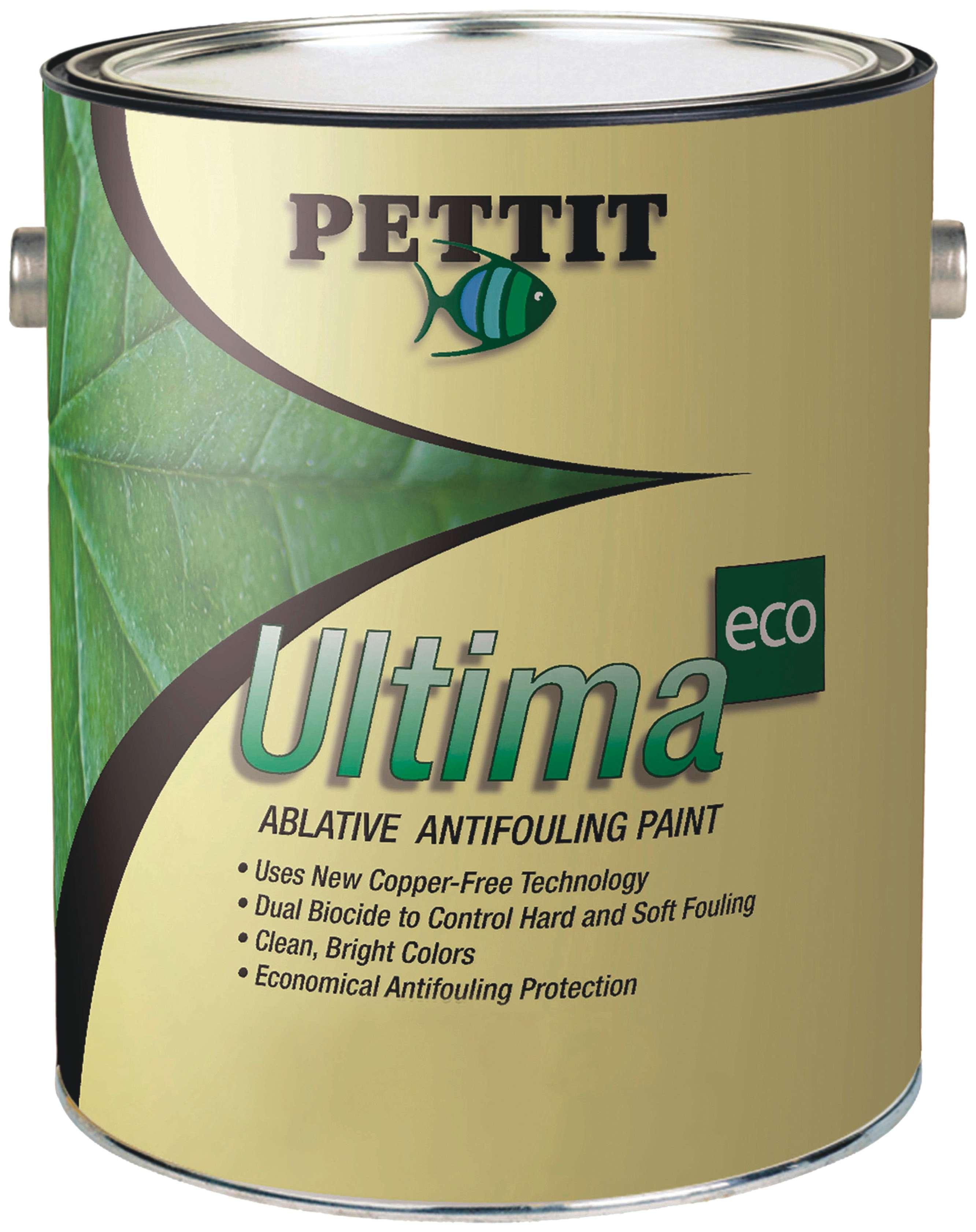
12 minute read
BOATING GREEN
By most measures, the green boating trend is a great thing. It’s good for the environment and it’s been good for business, as new manufacturers have emerged and established ones have continued to innovate. If there’s a knock against green products, it’s that sometimes there’s more marketing than substance behind their claims. (Imagine a picture of baby fur seals drinking boat wash out of shot glasses—“So safe, it’s a healthy snack!”)
The truth is, there are manufacturers putting good—dare we say, even great—science behind their products and improving them to the point that they equal or exceed the performance of traditional technologies. The challenge to boaters is discerning what’s marketing and what’s meaningful. This is complicated because there are no governmental regulations for what’s really meant by “green,” “environmentally safe,” “biodegradable,” “non-toxic” and other frequently used terms. In fact, some independent testing has shown that products that make no environmental claims can be a greener choice than products claiming to be so safe that Al “Ozone” Gore himself personally uses them. The answer is to do a little homework before you buy—first by digging into the manufacturer’s website and product information, and then by checking a few third-party sources. Following is a sample of ecosmart products that our GHM team has researched that will serve you well and keep your vessel in tip-top shape.

Aquagard
Aquagard’s anti-fouling paints are water-based and exceed federal and state VOC standards. The U.S. Environmental Protection Agency (EPA) also approves them. They still use copper, but have “perfected control of leach-out rates” to dramatically limit the amount of heavy metal needed for the paint to maintain yearlong effectiveness. Aquagard Bottom Paint is water-based, which minimizes the risk of toxic solvent exposure and means cleanup requires only soap and water. It’s multi-season ablative, only activates when it’s in the water and can be used over other hard ablative bottom paints. (aquagardboatpaint.com)
Bottom Business
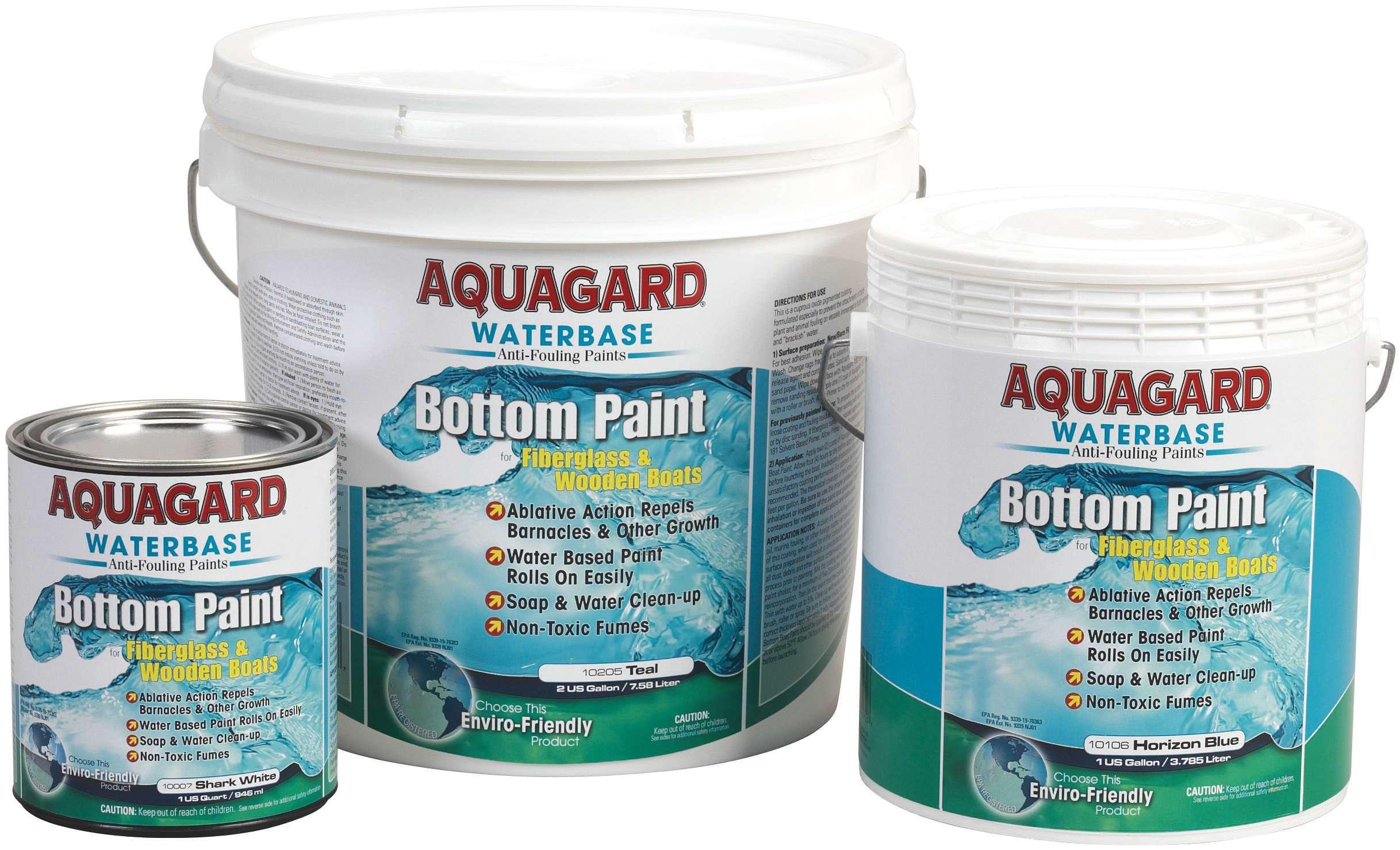
Traditional anti-fouling bottom paint is so noxious, one whiff will incinerate the nose hair of your children’s children. It’s the telltale sign that the paint contains VOCs, or Volatile Organic Compounds. Once applied to a boat hull, the paint slowly and steadily releases biocides (think: pesticides for marine life) that continually kill and prevent marine growth. A classic ingredient in this brew is copper, which, once released into the environment, can build up to undesirable and even toxic levels. While the impact of copper released from the bottom of one boat is pretty insignificant, the compound effect of all the boats in a large marina releasing copper year after year can have a real effect on local ecosystems.
Manufacturers have undertaken different strategies to make anti-fouling bottom paints less environmentally egregious. This includes using much less copper, but combining it with other, friendlier, compounds to use it more efficiently. Another method has been to create non-copper biocides that use different chemistry to kill off marine growth. Some paints are even water-based, avoiding the use of many harsh chemicals. We like this because not only is it environmentally friendly, but it makes clean-up a breeze and keeps our nose hair out of harm’s way.
Pettit Paints
Pettit’s Hydrocoat SR anti-fouling paint is driven by “Clean Core Technology,” which reduces the heavy metals found in traditional bottom paint by 40 percent. Like other products, this reduction is possible because of highly controlled biocide release rates that use a small amount of copper very efficiently. The company offers another product, Ultima Eco, which employs a completely metal-free biocide called Econea. It’s safe for use on all boat hulls, including aluminum. Both products can be used over most previously painted surfaces. (pettitpaints.com)
ePaint
The technology behind ePaint’s anti-fouling products, such as its EP-2000, is unique because it doesn’t use any copper at all. Instead, it is


chemically activated by light to combine water with dissolved oxygen molecules and form a hydrogen peroxide barrier around the boat hull. This creates a surface inhospitable to bio-fouling animal larvae, such as barnacles and zebra mussels. In addition, it uses special biocides (such as Zinc Omadine) formulated to have very short half-lives, meaning they break down quickly once released into the water. These biocides comprise only 5% by weight of the final paint product compared to 40-75% of copper in traditional formulas. How safe are these biocides? Zinc Omadine is a common ingredient in dandruff shampoo. (epaint.com)
Bubble Baths
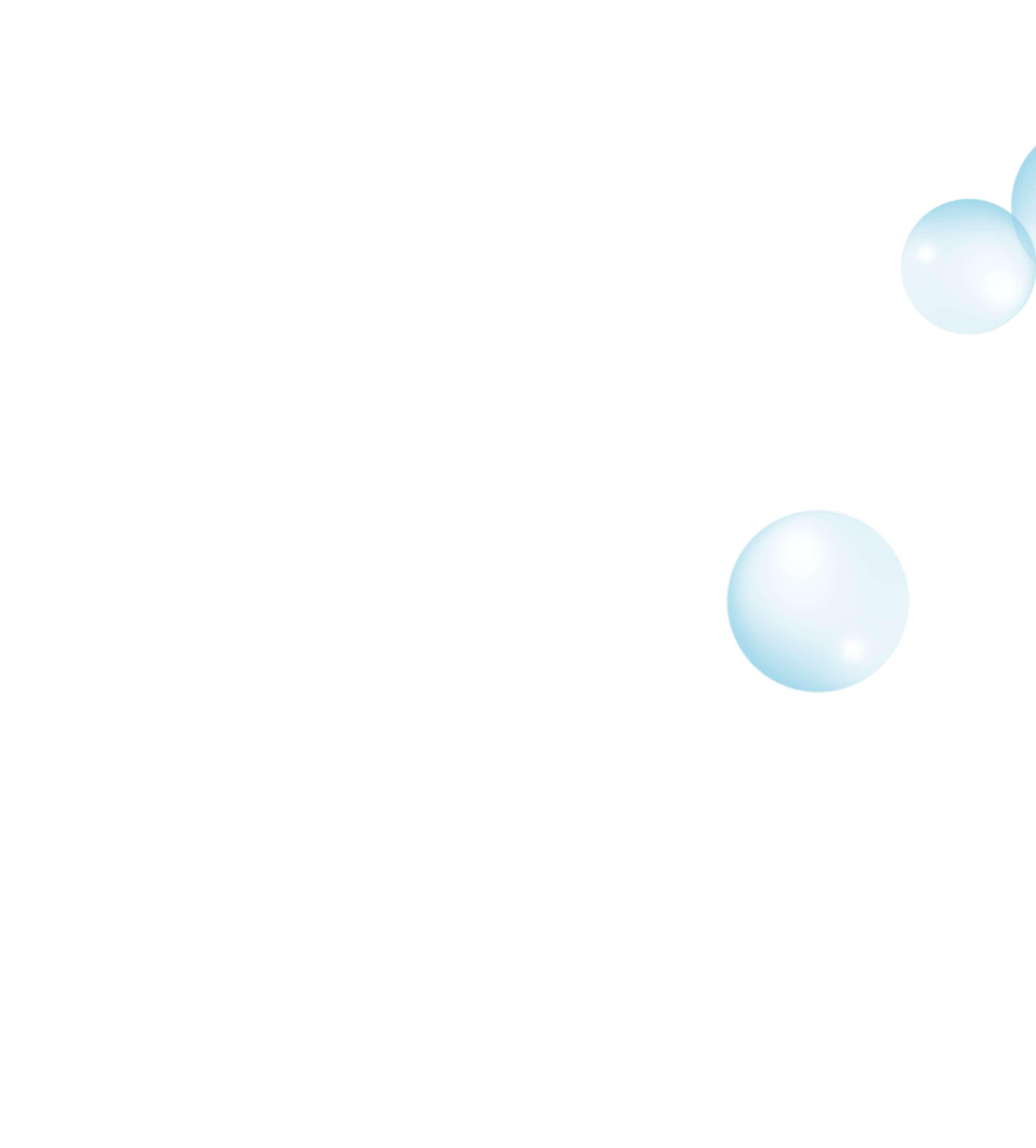
Boaters, especially offshore anglers, know that a good day on the water can leave your vessel well adorned in salt crystals, scuff marks and various forms of fish matter. The best response is an immediate and thorough wash down with an effective boat wash. Unless this is done in dry dock over a closed drainage system, the result is plenty of soapy runoff into the marina. In addition to using green boating products, there are several practical things boaters can do to minimize the environmental impact of the cleaners they use.
First and foremost is to use soaps and cleansers according to the manufacturer’s recommendations. Hyper-concentrated amounts of product “X” rarely work better than the dilution suggested on the label. When tough stains need to be addressed, spot-cleaning with a towel handy to soak up excess soaps or solvents is the best way to go. Regular maintenance is also important. It’s better to perform multiple light washings with a general cleaner rather than having to nuke your boat hull with high concentrations of noxious solvents to remove months of neglect.
When it comes to choosing a good boat wash, read the label. Citrus-based cleaners are generally a safe choice, as are those that invoke the name of the Environmental Protection Agency or recognized governmental or private certification agency. Here are a few of our favorites:
West Marine
Under their own label, boat retailing powerhouse West Marine sells an entire line of Pure Oceans boat care products, including Boat Soap, Deck Cleaner, Bilge Cleaner, Vinyl Cleaner, Hull Cleaner, Fiberglass Cleaner and (we think) even fingernail cleaner. Each lives up to the line’s mission, which includes using environmentally preferable alternatives that are less toxic, less environmentally persistent and less bio-accumulative than ingredients used in similar products. Most impressive is that all these claims are verified by third-party testing, and even the product packaging is minimal and comes from recycled or recyclable materials. (westmarine.com)
Star brite
The eco-friendly vibe at Star brite has been strong since the company was founded some four decades ago. We like their Super Orange Citrus Boat Wash, which is safe to use while the boat is in or near the water, and is low-sudsing, which minimizes rinse water. For tough waterline and rust stains, their Instant Hull Cleaner uses an environmentally-responsible, yet powerful, oxalic acid
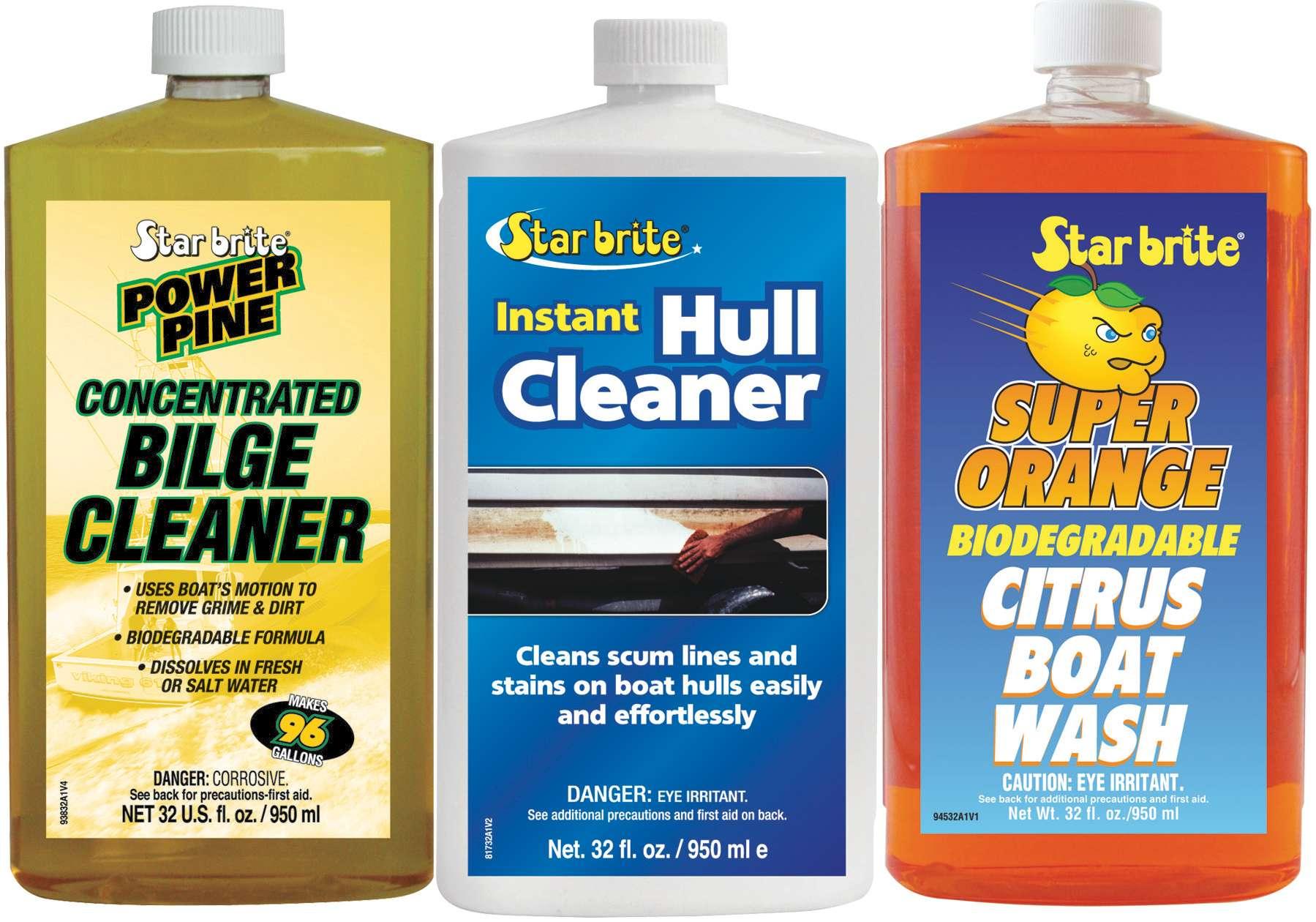
formulation. And, Star brite’s Super Green Cleaner/Degreaser is a biodegradable solution for spills while out on the boat. Sprayed directly on the stain or spill, it breaks it apart so that it can be rinsed clean with either saltwater or freshwater. The residue is designed not to harm sea life and to be for use on all marine surfaces. (starbrite.com)
Thetford
In 2008, Thetford joined a program that designates acceptable products as specifically “Designed for the Environment” by the EPA, meaning they use bestin-class components and meet stringent requirements for what the agency calls “safer chemistry.” Five of Thetford’s boat care products to hold this designation include their Boat Wash, Bilge Cleaner, Multi-Purpose Stain Remover, Ultra-Foam Deck Cleaner and Ultra-Foam Black Streak Remover. And, equally important to our readers, these products have a strong reputation for getting the job done. (thetford.com)

Beating Corrosion
If you’re like most boaters, you call them “zincs,” but they’re really anodes— sacrificial hunks of metal that redirect the slight electrical current created in water when two unlike metals are placed in close proximity. Forsake their replacement, and you’ll pay the price with a corroded prop or other damaged metallic structure. The problem, environmentally speaking, is that traditional zinc anodes contain cadmium, a heavy metal known to be toxic. Fortunately, there’s a greener alternative.
Martyr Anodes offers environmentally-friendly anodes for both salt and freshwater boaters. Martyr II Aluminum (for saltwater) and Martyr III Magnesium (for freshwater) anodes are cadmiumfree. Both are also lighter in weight than traditional zincs, something especially nice for sailboats. And, the aluminum anodes in particular have superior electro-chemical properties, making them perform more effectively and last longer than traditional counterparts. Still not sold? In recent years, aluminum anode prices have come more into line with old-school zincs, which means you might be all out of excuses not to switch. (martyranodes.com)
Getting Greener
Smart boat maintenance is really just the beginning of boating green. Fuel choices and efficiency, bilge cleaning, wastewater—there’s a greener way to do just about everything on a boat. From our view, the important thing is to simply start somewhere—and better buying habits when it comes to washing, painting and maintaining your boat is an easy first step. We suggest you take it. Al Gore and the fur seals will be happy you did.

An Australian flatback hatchling swims out to sea from a nesting beach. Right: Flatback hatchlings, unlike the hatchlings of other sea turtle species, remain in coastal waters, where the seawater is typically green and turbid. Dr. James Spotila, in his book on sea turtles, refers to Natator depressus as a “turtle of mystery,” about which we know “less…than any of the other six species.” Indeed, many of the most basic biological parameters of Australian flatback turtles remain unknown. “We just assume that they’re going to be like green turtles,” says Dr. Michael Guinea, “but the more we look at them, the more different we find out that they are.” In those life history features that are known, flatbacks often differ strikingly from other sea turtles. All other sea turtles, for example, complete a “pelagic dispersal phase,” circumnavigating entire ocean basins during their post-hatching developmental period. As a result, sea turtles are widely distributed throughout the tropical to warm temperate oceans of the world. Except, that is, for the Australian flatback, which never leaves the continental shelf of Australia. Hidden away in the most remote and treacherous marine environments of the continent, in waters shared with deadly venomous sea jellies, saltwater crocodiles, sea snakes, and large sharks, flatback turtles have remained little studied and little recognized. They had never even been professionally photographed underwater in their native habitat until these pictures were taken late last year.

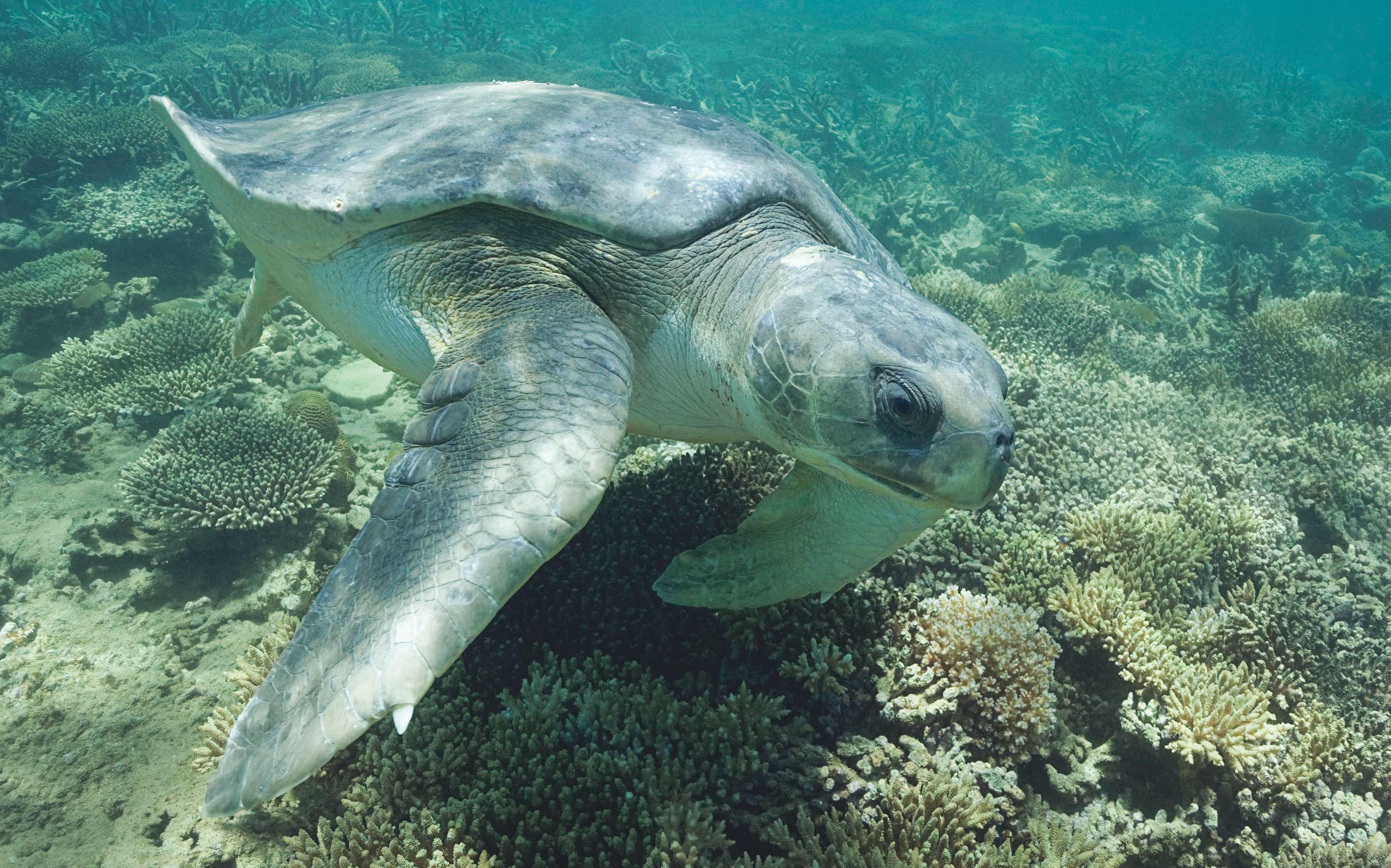
Below, Left to Right: A female flatback emerges from the sea and makes her way up the nesting beach to find a spot to lay her eggs; a female flatback covers her nest after laying her eggs; most sea turtle nesting occurs at night, but at some beaches it is quite common for flatbacks to nest during daylight; a flatback drops her eggs into the egg cavity carefully excavated within the body pit of her nest; after incubating under the beach sand for a little under two months, baby flatbacks hatch out of their eggs and dig upwards to the surface to emerge onto the beach; as with other sea turtles, most flatback hatchlings emerge at night, but at some nesting beaches it is not unusual to see baby flatbacks scrambling for the water in the late afternoon; survival is lower for daylight nest emergences due to predation by birds, lizards, fish and other animals.
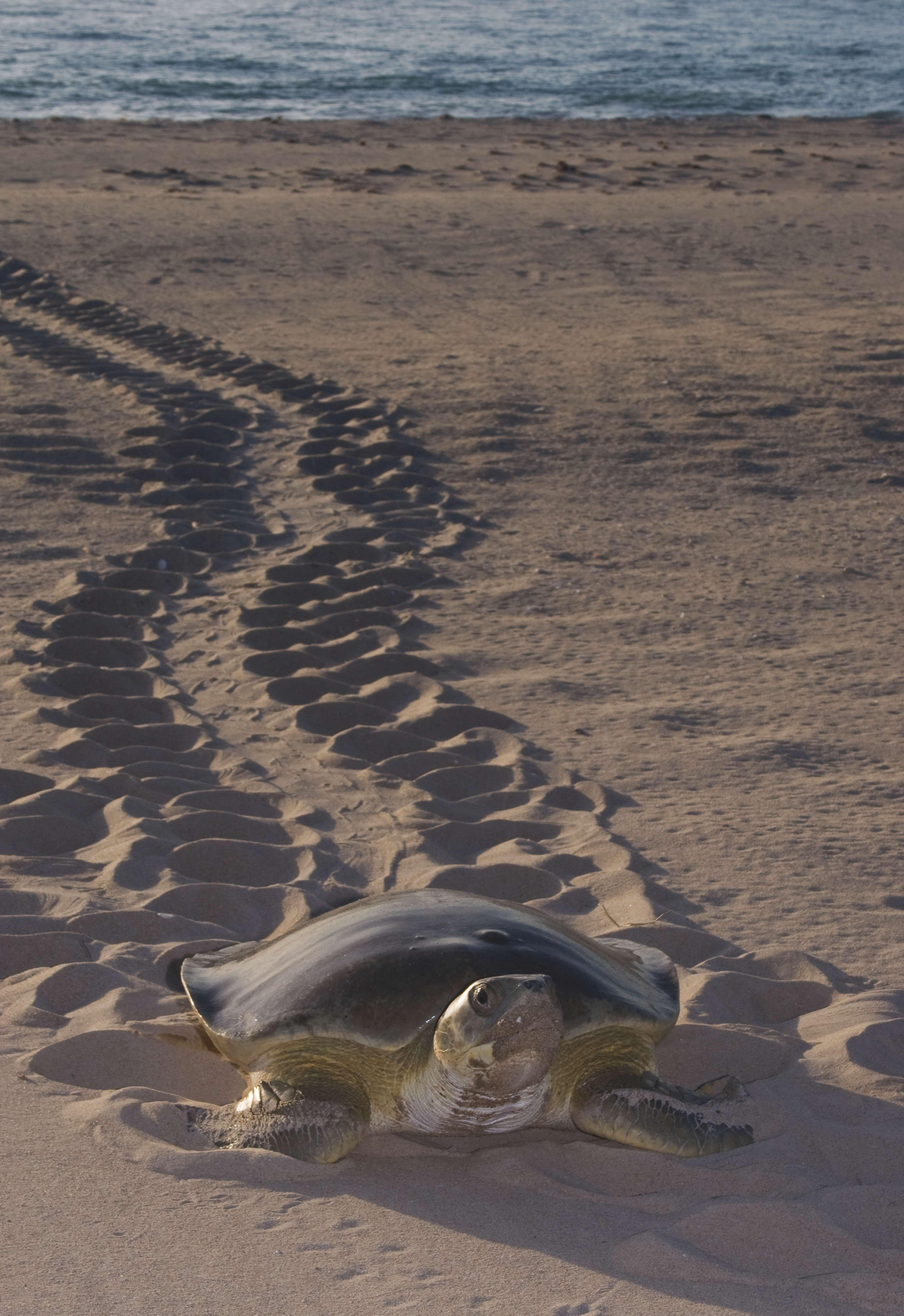


Top Left: An adult female flatback swims across a shallow coral reef that fringes the nesting beach and separates it from deeper, soft-bottom areas that the turtles use for feeding. Top Right: Flatback hatchlings are larger than those of other sea turtles when they enter the water; this is likely an adaptation for living in coastal waters with high densities of hungry fish.



At night, ghost crabs and saltwater crocodiles stalk the nesting beaches, preying on hatchlings; this crab was in the act of seizing a baby turtle when it was startled by an incoming wave and jumped up, releasing the turtle, which escaped.

A female rests on the sand just off a nesting beach while waiting for the right conditions to come ashore and lay her eggs; she has likely flippered the coating of sand onto her shell and head in an effort to camouflage herself from the large sharks and crocodiles that prowl the nesting beaches. This female flatback has a congenital deformity of the snout and nostril region; such defects are common in hatchlings, but the turtles rarely survive to adulthood.
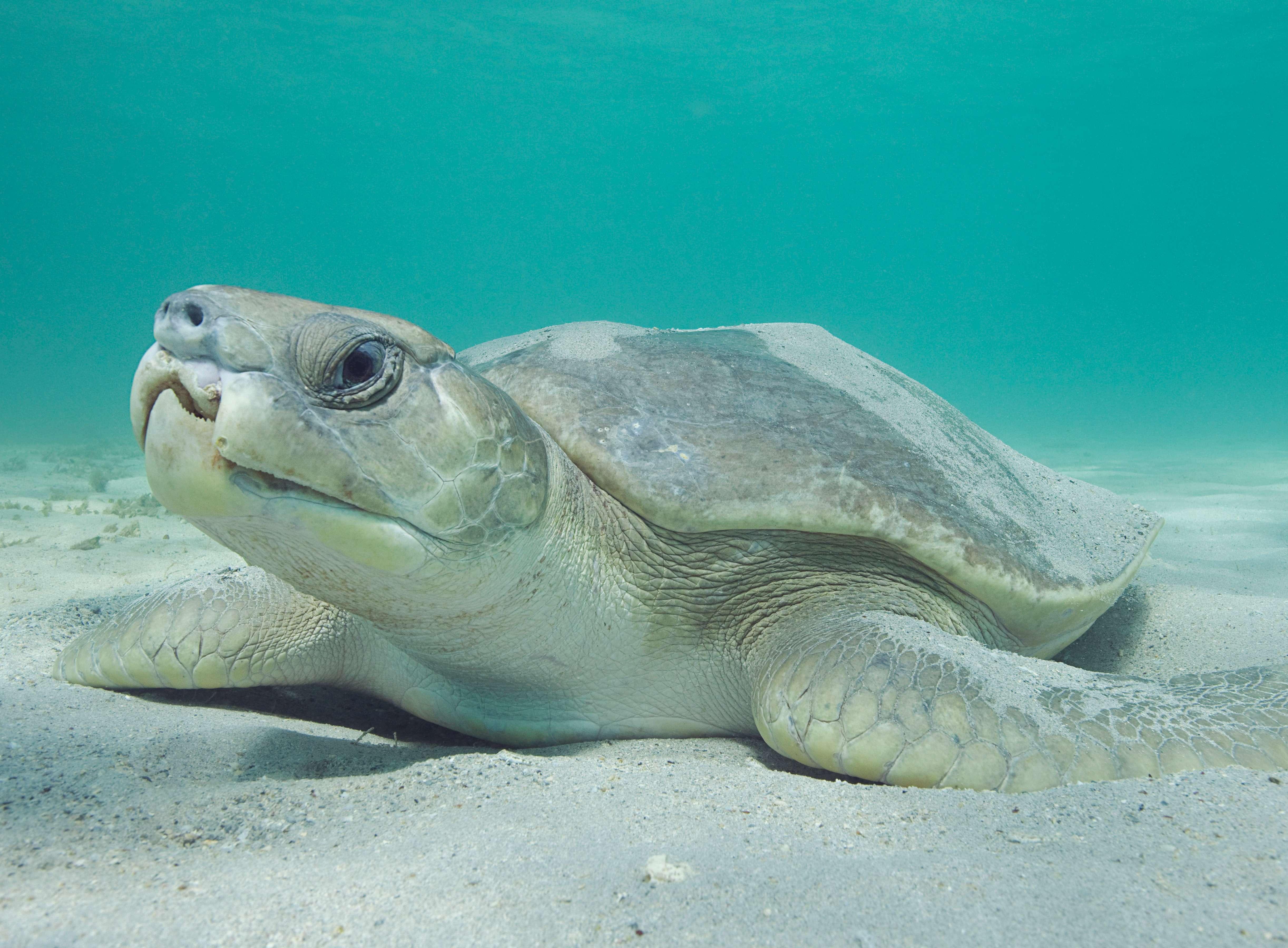



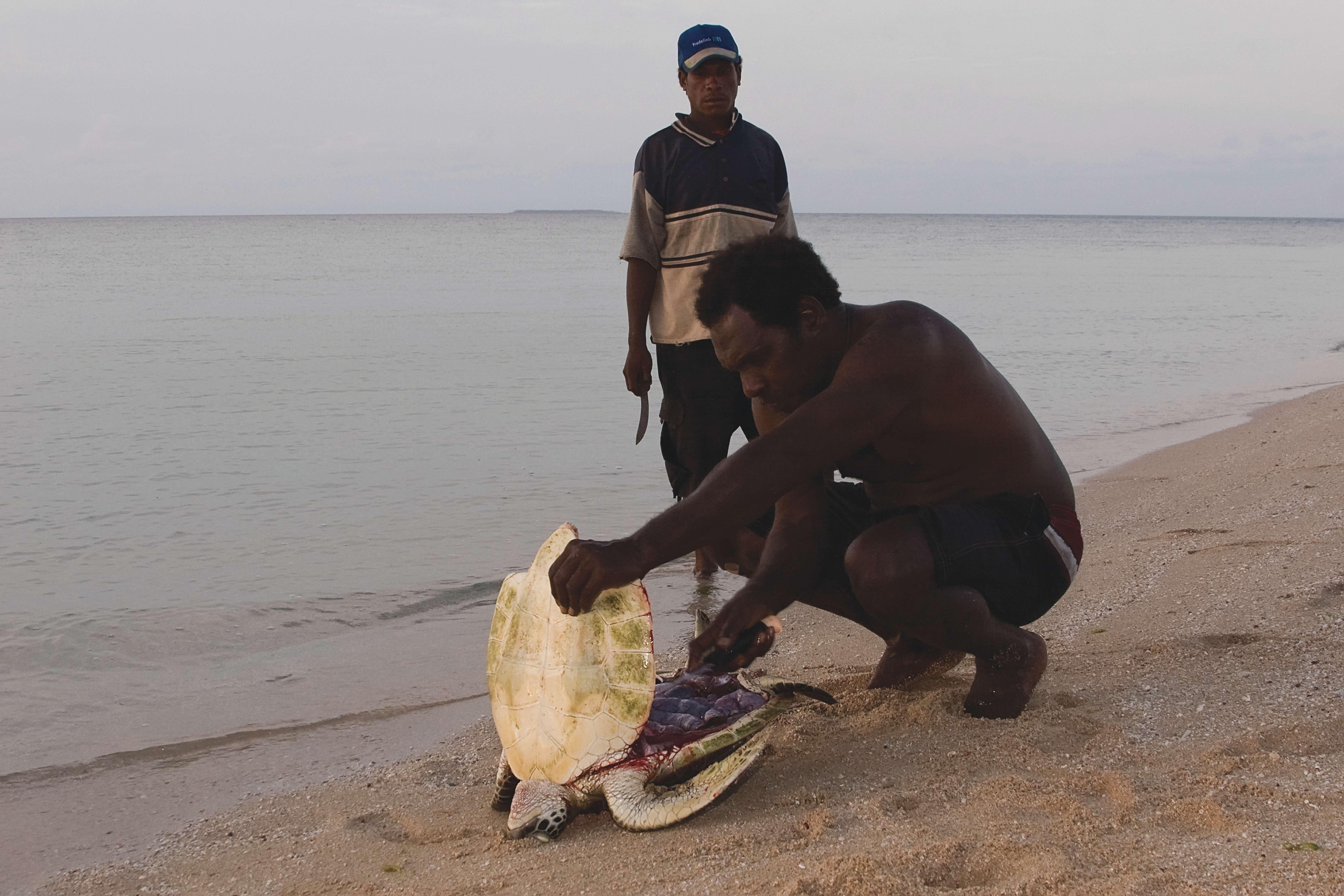

Clockwise from top left: A tiger shark scavenges a green turtle in an area frequented by both green and flatback turtles; massive bite scars on the shells of flatbacks show that they, too, are victims of tiger shark predation. Volunteers count and measure the eggs from a flatback nest; flatback eggs are larger than those of any other sea turtle in proportion to the adult body size, but the average number of eggs per nest is fewer than for other sea turtles; the larger eggs produce larger hatchlings—an adaptation for spending the early life stage in predator-rich environments. Biologist Kendra Coufal measures the carapace of a flatback turtle at the nesting beach on Curtis Island. Native islanders butcher a green turtle on a nesting beach used by both greens and flatbacks; flatbacks are also sometimes taken for food, but less commonly, as the flavor is considered less desirable; taking of flatback eggs for consumption is much more common; harvest of both eggs and adults by Aboriginals is allowed under Australian law.


Cape Lookout Lighthouse on Cape Lookout National Seashore. Photo courtesy of The Zimmerman Agency


